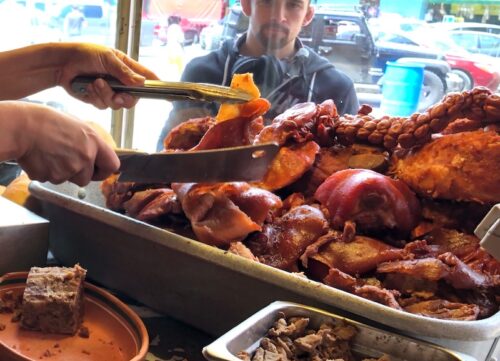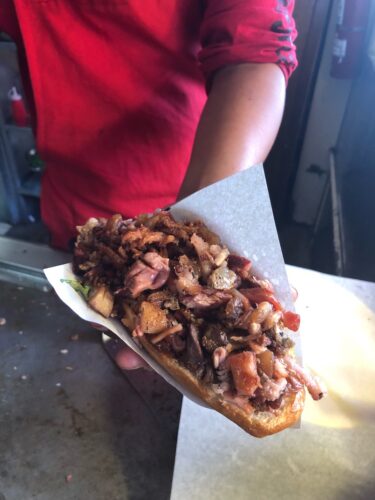The History of Carnitas & A Guide for Ordering

By Chris Mejia
With a history that harkens back before the founding of Mexico, carnitas (which literally means “little meats”) is one of Mexico’s most celebrated gastronomic traditions. Carnitas is a dish prepared by slow braising various cuts of the pork in its own lard, a culinary technique called “confit.” In Mexico, carnitas are often the centerpiece of celebrations, and are most commonly consumed by Mexicans on Sundays.
Served simply in a warmed tortilla as a taco, chopped carnitas are bathed with a freshly made salsa of choice, and commonly accompanied by pickled white onions, pickled carrot, pickled jalapeños, fresh shaved radish, and fresh chopped cilantro. A quintessential squeeze of fresh lime finishes the preparation. Acidic accompaniments like pickled vegetables and fresh lime are essential for “cutting” the fat from the pork on one’s palette, creating a pleasantly balanced dish.
Even many Mexicans are unfamiliar with the ancient origins of carnitas. As legend has it, this iconic Mexican dish originates with a celebration organized by Spanish conquistador Hernán Cortés in 1521. Some 500 years ago, pigs, which are not native to the Americas, were brought to the Caribbean Island of Hispaniola (today Haiti/Dominican Republic) by Spanish explorers. It’s said that Cortés then brought pigs from the Caribbean to what is Mexico today.
To celebrate the occupation of the Mexica/Azteca city of Tlatelolco with his captains (this occupation is widely purported to have precipitated the fall of the Aztecan Empire), Cortés organized a huge banquet in the ancient fortress of Coyoacán (located at the center of what’s modern-day Mexico City). To feed his celebratory crew, Cortés ordered the butchering and cooking of a pig in its own lard; the pig’s own lard being the only cooking oil on hand at the time. This slowly braised pork dish was accompanied with the Tlaxcalans’ corn bread (a thick corn tortilla) … which in turn gave birth to the iconic “taco de carnitas.”
While carnitas are enthusiastically eaten in all parts of Mexico today, the undisputed home of contemporary carnitas is the Mexican state of Michoacán (capital is Morelia). There is a pork eating culture in Michoacán, and it’s also where copper is mined (from Santa Clara del Cobre). Very large pots made of copper are traditionally used to cook the pork for carnitas. Copper being an excellent conductor of heat, cooks the meat evenly, and is also said to impart a more intense flavor in the meat.
Cooking carnitas in the Michoacán style involves a two-step, two pot, process. In the first step, and in the first pot, the big cuts of pork are “sealed” in boiling lard (at 350-375 degrees F) until a crust forms around the meat to seal in its juices. In the second step, the large hunks of pork are moved to a second pot, where they are then braised slowly in lard, with salt added, (at 195 degrees F) for 2 to 2.5 hours; until the now succulent meat is nearly falling apart.

A GUIDE TO ORDERING CARNITAS:
As is common in Mexico, no part of the animal goes unused when making carnitas. In Michoacán, locals traditionally eat their carnitas as a mix of all the parts of the pork meat combined (to order like a local, order your taco mixto — noting that it’s always the customer’s choice to include more or less of any cut). A combination of cuts lends a variety of tastes and textures to the taco. When ordering carnitas, you’ll be asked which cuts you prefer, so it’s best to go armed with a crib sheet! Here’s an abridged guide to the most common cuts:
- Maciza (combo of lean meats): known as the “gringo cut,” ordering maciza, or the lean meat cuts from the loins, legs, and shoulders of the pig, offers little risk, but also delivers less reward. These cuts, void of much intermuscular fat, tend to be the driest and least flavorful.
- Chamorro (leg meat): this is the best cut of the pig’s leg, where every bite imparts a little fat with the meat. For those who are less adventurous eaters, ordering chamorro generally offers a slightly more succulent bite than ordering maciza (see above).
- Costilla (rib meat): this cut is the tender meat that has been separated from the bones of the ribs. It’s more tender and juicier than maciza.
- Pancita (belly meat): a favorite amongst chefs the world over and often considered “the perfect cut,” the pig’s belly meat delivers what aficionados consider a perfect balance between tender meat and fat.
- Cueritos (soft skin): this is the thick, soft, and often chewy, gelatinous pork skin that is usually ordered/served in combination with another choice of meat(s) to lend a fatty component to your tacos. Cueritos are not to be confused with their crispy cousin, the chicharrón (see below).
- Chicharrón (crispy skin): not to be confused with cueritos (soft skin – see above), the pig’s skin is deep fried in lard at a higher temperature until it turns crispy and light. Often enjoyed on its own as a salty snack food, chicharrón can be added to other taco meats to provide a crispy component.
- Rabo (tail meat): sometimes referred to as pera, this cut has a gelatinous texture that is similar in mouthfeel to pig’s feet (manitas – see below), but with more fat than pig’s feet.
- Manitas (feet): small pieces of meat, fat, and cartilage cling to the bone, so you’ll have to pick them up and eat them with your hands to enjoy the manitas, or pig’s feet.
- Buche (stomach meat): quite literally the pig’s stomach (which has been thoroughly cleaned before cooking), this indulgent fatty cut boasts a light gelatinous texture and is often the cut of choice amongst carnitas aficionados.
- Trompa (face meat): a greasy and gelatinous cut that boasts a lot of flavor; ordering pig’s face is probably not for those who don’t want to quite literally face the animal they are consuming (ask for it to be chopped up finely to avoid recognition).
- Oreja (ear): a chewy cut that’s full of eatable cartilage, pig’s ears are usually consumed on their own as a treat, not in a taco (usually considered too chewy for a taco unless very finely chopped).
- Lengua (tongue): foodies know that tongue is a tender and tasty delicacy, and as such, you may have to beg the taquero (the local taco slinger) to release a bit that he’s kept in reserve for his best clients.
- Sesos (brains): quite literally the pig’s brains, this very tender cut that is considered a delicacy by some, melts in the mouth, and imparts an intense flavor.
- Bofe (lung): a cut that isn’t for the faint of heart, the pig’s lungs have a porous appearance and a slightly chewy texture.
- Tripa (intestine): considered a delicacy amongst foodies, the guts are thoroughly cleaned and then fried before being chopped up and served.
- Riñon (kidney): similar in texture and mouthfeel to the liver (hígado – see below), this cut (that’s been cleaned thoroughly before cooking) imparts a more subtle “fresh and earthy” flavor.
- Hígado (liver): with a very strong and intense flavor, the liver is very tender and tastes distinctly “earthy.” Fans of beef liver will likely enjoy pork liver.
- Corazón (heart): one of the most flavorful cuts of the pig, the heart tastes better than it looks. For those feeling a little adventurous, this is a good cut with which to start one’s culinary experimentation away from the traditional.
- Mollega (gizzards or sweetbreads): these tender glands impart a fatty taste and texture, and quite literally melt on the pallet. To enjoy mollega, be sure to arrive early, as they often sell out first.
- Nana (uterus): this cut delivers a unique taste that is tender and subtle.
- Achicalada (“pot luck”): this isn’t a specific cut of meat, but rather a mix of everything found at the bottom of the braising pot that is scooped up with a strainer. You won’t know exactly which parts of the meat are included when ordering achicalada, but the unique combination of succulent meats can be very rewarding.
- Mixto (mix of available cuts): a mix of available cuts at the time of ordering (cook’s choice), this is how many carnitas aficionados order their tacos de carnitas.

When ordering tacos de carnitas street-side from a taco cart, one simply calls out to the taquero which cuts of meat they wish to be included in the tacos. However, it’s far more popular in Mexico to eat carnitas at full-service sit-down restaurants that specialize in the preparation of carnitas. If you don’t know where to go, simply ask or follow the locals — almost every municipality will have its local’s favorite carnitas joint, and locals won’t shy away from showing you where it is. In full-service restaurants, it’s typical to order the components of your tacos separately (a la carte, by the kilo or half kilo), choosing one’s cuts of meat to be included, then self-assembling the tacos to taste at the table (tortillas, a selection of salsas, veggies, and cut limes are typically included when ordering by the kilo, but check with your server to be sure).
In addition to tacos de carnitas (the most ubiquitous preparation for carnitas), carnitas meat is also commonly found in tortas (Mexican sandwiches), including the famous Guadalajaran derivation known as a torta ahogada (a carnitas sandwich “drowned” in sauce). Less common in Mexico, you may find carnitas as the base meat in burritos or flautas at some tourist restaurants. But for an authentic experience, find the best “Carnitas Michoacán” restaurant in the area you are visiting, order ala-carte with your family and friends, and celebrate this historical Mexican culinary tradition family style, just as the locals do.
A few of my favorite carnitas joints in Baja California:
- “Carnitas El Jerezano” in Tijuana, inside of the Mercado Hidalgo, Tijuana’s central produce market (you’ll find convenient and relatively safe paid parking inside the market; ask any vendor for a parking discount voucher)
- “Carnitas La Flor Michoacán” located in Rosarito on Blvd. Benito Juarez (the main drag) on the north side of town (serving carnitas to locals and tourists alike since 1950)
- “Carnitas Michoacán Ensenada” located in a residential neighborhood south of the tourist area (you’ll want to drive or Uber; easy street parking is available)
- “Carnitas TADEO” located in Todos Santos, B.C.S. on the main drag coming into town from the south (seating is open air in this rustic restaurant that is a local’s favorite)
Chris Mejia is an experienced culinary guide, food writer, and self-proclaimed “gastronomer” who has spent years exploring and curating the best of Baja California’s vibrant food scene. Follow Chris on Instagram and Facebook @MrStretchyPants.

Great, easy to understand explanation of how to order carnitas. Thank you!
La Flor de Michoacan has my vote for #1. been enjoying their most wonderful carnitas for nearly 50 years. Always tasty. The best!!
The best carnitas I have ever had. Been eating there for almost 50 years! Never disappoints.